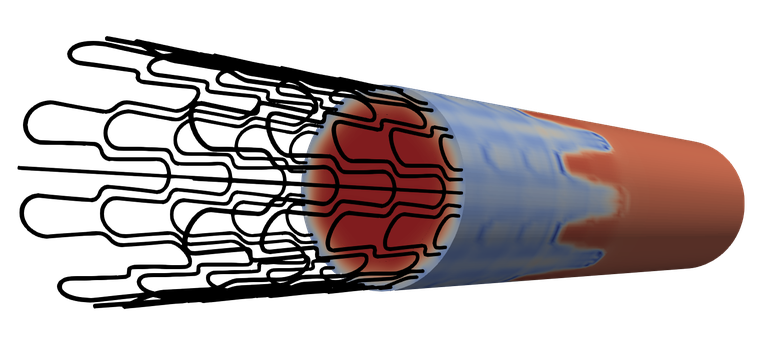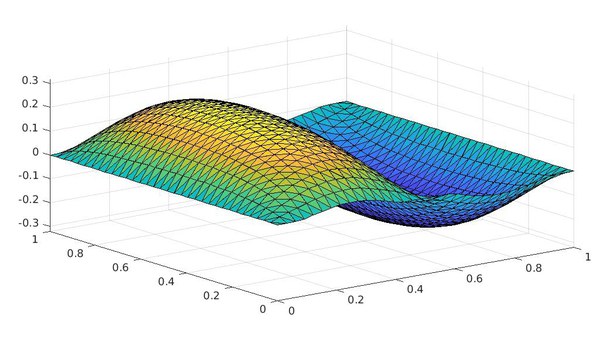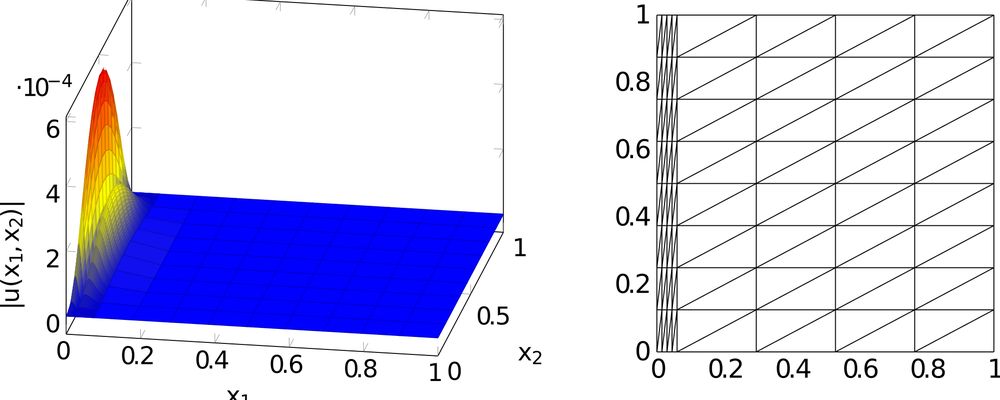Gemischt-dimensionale Modelle für die Interaktion zwischen Fasern und Fluiden

| Zeitraum | 2018-2023 |
| Kurzbeschreibung | Dieses Projekt zielt darauf ab, hocheffiziente gemischt-dimensionale Mortar-Finite-Elemente-Methoden zu entwickeln, die speziell auf die Modellierung der Wechselwirkung von sehr schlanken Stäben mit den 3-dimensionalen inkompressiblen Navier-Stokes-Gleichungen zugeschnitten sind. Die Wechselwirkung solcher balkenartigen Strukturen mit Fluidströmungen spielt eine wichtige Rolle in einem breiten Spektrum von Anwendungen, die von biomechanischen bis zu industriellen Prozessen reichen. Zu diesen Anwendungen gehören beispielsweise die Wechselwirkung endovaskulärer Geräte mit Blutfluss und der Einsatz faseriger Verkleidungen zur Strömungskontrolle. Am IMCS konzentrieren wir uns auf die Entwicklung spezieller 1D-3D-Kopplungsansätze, die relativ grobe Hintergrundnetze zulassen, um die Vorteile - z.B. in Bezug auf die Systemgröße, die Löserzeit sowie die Auswertung der Kopplungsterme selbst - der Verwendung einer reduzierten-dimensionalen Strukturformulierung zu erhalten. Besonderes Augenmerk wird auf die Anwendung effizienter und skalierbarer paralleler Algorithmen gelegt, die in der Lage sind, große und komplexe technische Anwendungen zu bewältigen. |
| Kontakt am IMCS | Dr.-Ing. Matthias Mayr, Nora Hagmeyer M.Sc. |
Gemischt-dimensionale Kopplungsstrategien in der Festkörpermechanik

| Zeitraum | 2018-2022 |
| Partner |
Lehrstuhl für Numerische Mechanik, TU München |
| Kurzbeschreibung |
In verschiedenen technischen und biomechanischen Anwendungen verbessert die Integration schlanker Fasern in dreidimensionale Körper die mechanischen Eigenschaften der Gesamtstruktur erheblich. In diesem Projekt werden neuartige Kopplungsmethoden für solche Probleme entwickelt, bei denen die Fasern explizit mit eindimensionalen (1D) Balkentheorien modelliert werden, was zu einer sehr genauen und effizienten numerischen Formulierung führt. Für die 3D-Körper werden modernste Finite-Elemente-Methoden (FEM) verwendet. Solche Ansätze werden auch als gemischt-dimensionale Kopplung bezeichnet, da die zugrunde liegenden Differentialgleichungen auf Gebieten mit unterschiedlichen Dimensionen definiert sind. Ein wesentlicher Vorteil dieser gemischt-dimensionalen Methoden ist die Einfachheit der Modellerstellung, da die 1D-Fasern und 3D-Körper unabhängig voneinander diskretisiert werden können. Im Rahmen dieses Projekts wurden bereits erfolgreich Kopplungsmethoden für eingebettete Fasern in Volumina (1D-3D) und Fasern, die mit Oberflächen verbunden sind oder in Kontakt stehen (1D-2D), auf der Grundlage der Mortar/Lagrange-Multiplikatormethoden entwickelt. |
| Kontakt am IMCS | Dr.-Ing. Ivo Steinbrecher |
Optimalsteuerprobleme für elliptische Variationsungleichungen
| Fördergeber | Deutsche Forschungsgemeinschaft (DFG) innerhalb des Internationalen Graduierten- und Doktorandenkollegs IGDK 1754 mit dem Titel Optimization and Numerical Analysis for Partial Differential Equations with Nonsmooth Structures |
| Zeitraum | 2017-2022 |
| Partner | Technische Universität München (Prof. Vexler) Technische Universität Graz (Prof. Steinbach) |
| Kurzbeschreibung |
Das Projekt beschäftigt sich mit der optimalen Steuerung von Variationsungleichungen. Neben a priori Fehlerabschätzungen für Finite-Elemente Diskretisierungen von Optimalsteuerproblemen für elliptische Variationsungleichungen werden auch verschiedene Regularisierungsstrategien untersucht. Weiter Informationen sind hier zu finden. |
| Kontakt am IMCS |
Anisotrope druckrobuste Diskretisierungen von inkompressiblen Strömungen
| Zeitraum | 2018-2022 |
| Partner | Weierstrass Institut für angewandte Analysis und Stochastik (Priv.-Doz. Dr. Alexander Linke, Dr. Christian Merdon) |
| Kurzbeschreibung | Im Mittelpunkt des Projekts steht die Entwicklung von Fehlerabschätzungen für Diskretisierungen der Navier-Stokes-Gleichungen auf anisotrop verfeinerten Netzen, bei denen der Geschwindigkeitsfehler unabhängig von der Druckapproximation ist. Weitere Informationen finden Sie hier. |
| Kontakt am IMCS |
Experimentelle Charakterisierung und Numerische Simulation des Automated Fiber Placement (AFP)-Prozesses für Faserverbundkunststoffe

| Fördergeber | Deutsche Forschungsgemeinschaft (DFG), PO 1883/3-1 |
| Zeitraum | 2017-2021 |
|
Partner |
Lehrstuhl für Carbon Composites, TU München (Prof. Drechsler) Lehrstuhl für Numerische Mechanik, TU München (Prof. Wall) |
| Kurzbeschreibung | Die effiziente, qualitativ hochwertige und reproduzierbare Herstellung von thermoplastischen faserverstärkten Kunststoffbauteilen erfordert automatisierte Fertigungsprozesse. Das automatisierte Faserplatzieren (AFP) hat durch die lastpfadorientierte Ablage von Fasern zu endkonturnahen Bauteilen ein besonders großes Potenzial. Bei geeigneter Temperaturführung während des thermoplastischen AFP (TP-AFP) ist eine In-situ-Konsolidierung möglich, d.h. eine Verfestigung anstelle des Prozesses ohne nachgeschaltete Aushärtung. Das Verständnis des Prozesses ist jedoch noch weit davon entfernt, den für eine breite industrielle Anwendung von TP-AFP erforderlichen Reifegrad zu erreichen. So ist es heute noch schwierig, für die wichtigsten Schlüsselparameter wie Laserleistung, Geschwindigkeit und Verdichtungsdruck geeignete Prozessfenster zu definieren, um eine gleichbleibend hohe Qualität der Bauteile zu gewährleisten. Insbesondere die Vorhersage von Eigenspannungen und Verzug ist nur unzureichend gelöst und die Prozesskalibrierung basiert häufig auf einer Trial-and-Error-Methode. Die Gründe für diese Diskrepanz zwischen geringer Vorhersagegenauigkeit und hohen industriellen Anforderungen sind ebenfalls auf noch nicht ausgeschöpfte Möglichkeiten der experimentellen Charakterisierung sowie der Modellierung und Simulation zurückzuführen. Ziel dieses Projektes ist es daher, das Prozessverständnis im Bereich der TP-AFP durch neuartige experimentelle Untersuchungen und Methoden der numerischen Simulation grundlegend zu verbessern. |
| Kontakt am IMCS | Prof. Dr.-Ing. Alexander Popp |
Bottom-Up-Modellierung von Stents und Stentgrafts für die Endovaskuläre Aortenreparatur (EVAR) von Aneurysmen

| Fördergeber | Daimler und Benz Stiftung | |
| Zeitraum | 2016-2018 | |
| Partner | Institute of Industrial Science, The University of Tokyo, Japan (Prof. Oshima) | |
| Kurzbeschreibung | Das Einsetzen von arteriellen Stents hat sich zu einem sehr wichtigen und erfolgreichen Eingriff in der Gefäßchirurgie entwickelt. Eines der häufigsten Szenarien sind sogenannte selbstexpandierbare Stentgrafts, die aus einem speziellen Gewebetransplantat und einem Metallstentnetz bestehen. Stentgrafts werden bei der endovaskulären Aortenreparatur (EVAR) eingesetzt, um schwache, lokalisierte Ausbuchtungen (Aneurysmen) in einer rupturgefährdeten Arterie zu stützen, am häufigsten bei abdominalen Aortenaneurysmen (AAA). In den letzten zehn Jahren hat es einen enormen Forschungsschub bei der computergestützten Analyse biomedizintechnischer Probleme im Allgemeinen und bei der Gefäßmechanik und AAA im Besonderen gegeben. Obwohl bedeutende Fortschritte erzielt wurden, ist die rechnerische Analyse von AAA-Stentgrafts mit Hilfe von Finite-Elemente-Methoden (FEM) immer noch nicht aussagekräftig genug, um Gefäßchirurgen spezifische Ratschläge für die optimale Platzierung des Geräts während einer EVAR zu geben. Zu den möglichen Risiken, die bei weitem noch nicht vollständig verstanden sind, gehören eine Bewegung der Stents weg von der gewünschten Stelle (Migration), das Austreten von Blut um die Stentgrafts (Endoleckage) und die Beschädigung der Arterienwand durch den Stent selbst. Das Hauptziel dieses Projekts ist die Entwicklung, Implementierung und Validierung neuer innovativer FEM-Simulationswerkzeuge für AAA-Stentgrafts auf der Grundlage eines Bottom-up-Modellierungsansatzes. Alle relevanten mikrogeometrischen und mechanischen Merkmale der komplexen Stentgraft-Designs werden in die neuen Modelle einbezogen, was eine erhebliche Steigerung der Effizienz der Simulation ermöglicht. | |
| Kontakt am IMCS | Prof. Dr.-Ing. Alexander Popp |
Neuartige Glatte Diskretisierungsansätze für Elastoplastischen Kontakt bei Festkörpern und Dünnen Strukturen

| Fördergeber | Deutsche Forschungsgemeinschaft (DFG), PO 1883/1-1 im Rahmen des Schwerpunkprogramms SPP 1748 |
| Zeitraum | 2014-2017 |
| Partner | Lehrstuhl für Numerische Mathematik, TU München (Prof. Wohlmuth) |
| Kurzbeschreibung | Ziel dieses Projekts war die Einführung einer neuen Diskretisierungsmethode für den Kontakt von sperrigen und dünnwandigen Strukturen, die ausgeprägte geometrische und materielle Nichtlinearitäten aufweisen. Der daraus resultierende Ansatz zur Glättung von Kontakten geht im Hinblick auf eine solide mathematische Grundlage über die traditionellen Glättungsverfahren hinaus, behält aber gleichzeitig die Einfachheit von Finite-Elemente-Diskretisierungen niedriger Ordnung im Großteil des Berechnungsbereichs bei. Volumen- und Kontaktflächendiskretisierungen sind strikt getrennt, aber über variabel konsistente Kopplungsoperatoren auf der Basis generischer biorthogonaler Lagrange-Multiplikatorbasen miteinander verknüpft. Dieser neue Ansatz verspricht maximale Flexibilität im Hinblick auf eine glatte Oberflächendiskretisierung (z.B. mit FEM höherer Ordnung, Hermite-Interpolation, Splines oder NURBS) und eine völlig unabhängige Volumendiskretisierung (z.B. mit nicht-konformer FEM niedriger Ordnung, EAS oder F-Bar-Techniken). Darüber hinaus wurde eine integrierte Behandlung von Kontakt und Reibung sowie finiter Dehnungsplastizität auf der Grundlage sogenannter nichtlinearer Komplementaritätsfunktionen und semi-smooth Newton-Methoden entwickelt, die im Vergleich zu traditionellen radialen Rückführungsschemata eine höhere Robustheit bieten. |
| Kontakt am IMCS | Prof. Dr.-Ing. Alexander Popp |
Robuste Simulationsmethoden für Kontakt, Reibung, Abrieb und Verschleiß in Verbindungselementen von Flugtriebwerken

| Fördergeber | Rolls-Royce Deutschland Ltd & Co KG im Rahmen des Luftfahrtforschungsprogramms des BMWi |
| Zeitraum | 2007-2017 |
| Partner | Rolls-Royce plc (U.K.) |
| Kurzbeschreibung | Langfristige industrielle Zusammenarbeit (über 10 Jahre) mit mehreren Teilprojekten, die sich mit robusten Diskretisierungsschemata und Lösungsalgorithmen für Kontaktprobleme in Turbinenschaufel-Scheiben-Verbindungen befassten. Neue Berechnungsmethoden für Domänenzerlegung, Reibungskontakt, Reibungsverschleiß und Reibermüdung wurden entwickelt, validiert und in den internen Finite-Elemente-Code des Industriepartners integriert. Beratung zu Hochleistungsrechnern (HPC). |
| Kontakt am IMCS | Prof. Dr.-Ing. Alexander Popp |


